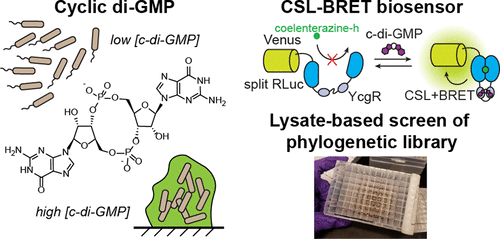当前位置:
X-MOL 学术
›
ACS Chem. Biol.
›
论文详情
Our official English website, www.x-mol.net, welcomes your
feedback! (Note: you will need to create a separate account there.)
Chemiluminescent Biosensors for Detection of Second Messenger Cyclic di-GMP
ACS Chemical Biology ( IF 3.5 ) Pub Date : 2018-02-21 00:00:00 , DOI: 10.1021/acschembio.7b01019 Andrew B. Dippel 1 , Wyatt A. Anderson 1 , Robert S. Evans 2 , Samuel Deutsch 2 , Ming C. Hammond 1, 3
ACS Chemical Biology ( IF 3.5 ) Pub Date : 2018-02-21 00:00:00 , DOI: 10.1021/acschembio.7b01019 Andrew B. Dippel 1 , Wyatt A. Anderson 1 , Robert S. Evans 2 , Samuel Deutsch 2 , Ming C. Hammond 1, 3
Affiliation

|
Bacteria colonize highly diverse and complex environments, from gastrointestinal tracts to soil and plant surfaces. This colonization process is controlled in part by the intracellular signal cyclic di-GMP, which regulates bacterial motility and biofilm formation. To interrogate cyclic di-GMP signaling networks, a variety of fluorescent biosensors for live cell imaging of cyclic di-GMP have been developed. However, the need for external illumination precludes the use of these tools for imaging bacteria in their natural environments, including in deep tissues of whole organisms and in samples that are highly autofluorescent or photosensitive. The need for genetic encoding also complicates the analysis of clinical isolates and environmental samples. Toward expanding the study of bacterial signaling to these systems, we have developed the first chemiluminescent biosensors for cyclic di-GMP. The biosensor design combines the complementation of split luciferase (CSL) and bioluminescence resonance energy transfer (BRET) approaches. Furthermore, we developed a lysate-based assay for biosensor activity that enabled reliable high-throughput screening of a phylogenetic library of 92 biosensor variants. The screen identified biosensors with very large signal changes (∼40- and 90-fold) as well as biosensors with high affinities for cyclic di-GMP (KD < 50 nM). These chemiluminescent biosensors then were applied to measure cyclic di-GMP levels in E. coli. The cellular experiments revealed an unexpected challenge for chemiluminescent imaging in Gram negative bacteria but showed promising application in lysates. Taken together, this work establishes the first chemiluminescent biosensors for studying cyclic di-GMP signaling and provides a foundation for using these biosensors in more complex systems.
中文翻译:

化学发光生物传感器,用于检测第二信使循环di-GMP
细菌在从胃肠道到土壤和植物表面的高度多样化和复杂的环境中定居。此定殖过程部分受细胞内信号循环di-GMP的控制,后者调节细菌的运动性和生物膜的形成。为了询问循环二GMP信号网络,已经开发了用于循环二GMP的活细胞成像的多种荧光生物传感器。但是,由于需要外部照明,因此无法使用这些工具对自然环境中的细菌进行成像,包括在整个生物体的深层组织中以及在高度自发荧光或光敏性样品中进行成像。对基因编码的需求也使临床分离株和环境样品的分析变得复杂。为了将细菌信号传导的研究扩展到这些系统,我们已经开发出首个用于环二GMP的化学发光生物传感器。生物传感器设计结合了分裂荧光素酶(CSL)和生物发光共振能量转移(BRET)方法的互补性。此外,我们针对生物传感器活性开发了基于裂解物的检测方法,该方法能够对92个生物传感器变体的系统发育文库进行可靠的高通量筛选。该屏幕确定了信号变化非常大(约40倍和90倍)的生物传感器,以及对环二GMP具有高亲和力的生物传感器(我们针对生物传感器活性开发了基于裂解物的测定法,该方法能够对92个生物传感器变体的系统发育文库进行可靠的高通量筛选。该屏幕确定了信号变化非常大(约40倍和90倍)的生物传感器,以及对环二GMP具有高亲和力的生物传感器(我们针对生物传感器活性开发了基于裂解物的测定法,该方法能够对92个生物传感器变体的系统发育文库进行可靠的高通量筛选。该屏幕确定了信号变化非常大(约40倍和90倍)的生物传感器,以及对环二GMP具有高亲和力的生物传感器(K D <50 nM)。然后将这些化学发光生物传感器用于测量大肠杆菌中的循环di-GMP水平。细胞实验揭示了革兰氏阴性细菌化学发光成像所面临的意外挑战,但在裂解液中显示出了广阔的应用前景。两者合计,这项工作建立了第一个化学发光生物传感器,用于研究循环di-GMP信号,并为在更复杂的系统中使用这些生物传感器提供了基础。
更新日期:2018-02-21
中文翻译:

化学发光生物传感器,用于检测第二信使循环di-GMP
细菌在从胃肠道到土壤和植物表面的高度多样化和复杂的环境中定居。此定殖过程部分受细胞内信号循环di-GMP的控制,后者调节细菌的运动性和生物膜的形成。为了询问循环二GMP信号网络,已经开发了用于循环二GMP的活细胞成像的多种荧光生物传感器。但是,由于需要外部照明,因此无法使用这些工具对自然环境中的细菌进行成像,包括在整个生物体的深层组织中以及在高度自发荧光或光敏性样品中进行成像。对基因编码的需求也使临床分离株和环境样品的分析变得复杂。为了将细菌信号传导的研究扩展到这些系统,我们已经开发出首个用于环二GMP的化学发光生物传感器。生物传感器设计结合了分裂荧光素酶(CSL)和生物发光共振能量转移(BRET)方法的互补性。此外,我们针对生物传感器活性开发了基于裂解物的检测方法,该方法能够对92个生物传感器变体的系统发育文库进行可靠的高通量筛选。该屏幕确定了信号变化非常大(约40倍和90倍)的生物传感器,以及对环二GMP具有高亲和力的生物传感器(我们针对生物传感器活性开发了基于裂解物的测定法,该方法能够对92个生物传感器变体的系统发育文库进行可靠的高通量筛选。该屏幕确定了信号变化非常大(约40倍和90倍)的生物传感器,以及对环二GMP具有高亲和力的生物传感器(我们针对生物传感器活性开发了基于裂解物的测定法,该方法能够对92个生物传感器变体的系统发育文库进行可靠的高通量筛选。该屏幕确定了信号变化非常大(约40倍和90倍)的生物传感器,以及对环二GMP具有高亲和力的生物传感器(K D <50 nM)。然后将这些化学发光生物传感器用于测量大肠杆菌中的循环di-GMP水平。细胞实验揭示了革兰氏阴性细菌化学发光成像所面临的意外挑战,但在裂解液中显示出了广阔的应用前景。两者合计,这项工作建立了第一个化学发光生物传感器,用于研究循环di-GMP信号,并为在更复杂的系统中使用这些生物传感器提供了基础。











































 京公网安备 11010802027423号
京公网安备 11010802027423号